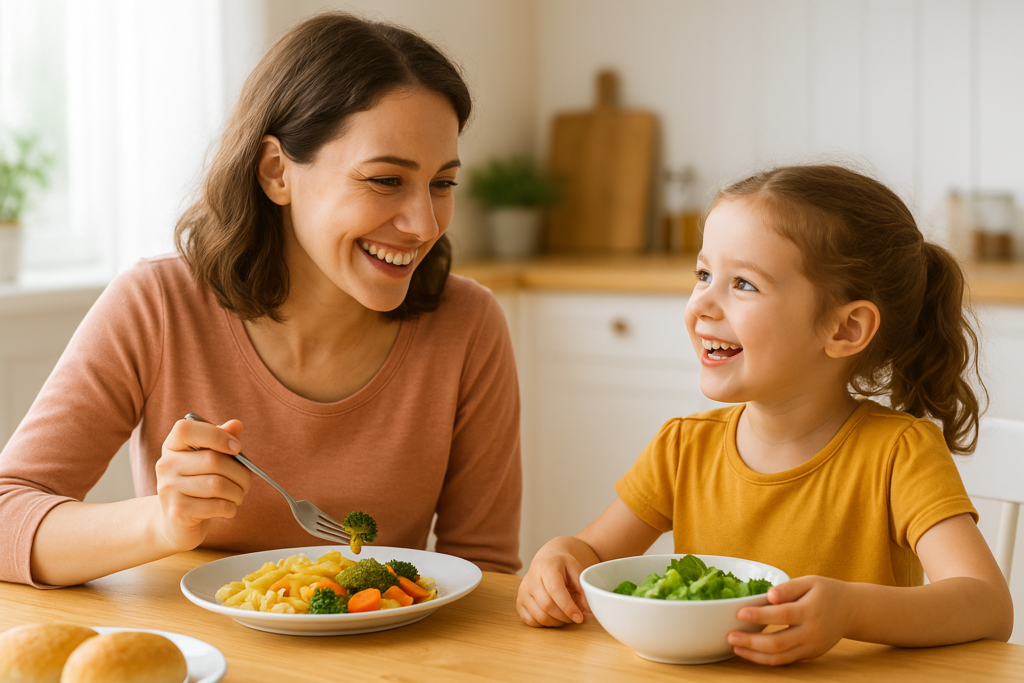Your 4-year-old is listening to every word you say about food. While you might casually mention that cookies will “make you fat” or that you’re “being bad” for having dessert, those little ears are absorbing far more than you realize.
Children are incredible observers. They soak up not just our words but also our attitudes, emotions, and behaviors around food.
The reality is both sobering and empowering: as parents, we hold tremendous influence over our children’s future relationship with food and their bodies.
The stakes couldn’t be higher. Research shows that parents’ attitudes and language around food can either protect children from eating disorders—or plant the seeds for poor body image and damaged self-esteem.
But here’s the empowering truth: once we become aware of our impact, we can choose to be intentional. This guide will help you examine your own food attitudes and provide strategies to model positive behaviors.
The Hidden Impact of Our Food Language
Let’s start by examining what children really hear when we speak about food. Often, there’s a disconnect between what we think we’re communicating and what our children are actually learning from our words.

“I’m being so bad eating this cake.”
Children learn that food choices are moral decisions—“good” or “bad”—which sets the stage for guilt and shame.
They begin to associate eating certain foods with being “good” or “bad” people, rather than understanding that food is simply nourishment and pleasure. This moral framework around eating sets the stage for guilt and shame that can persist into adulthood.
“This will make you fat.”
Children internalize fear and believe certain foods are dangerous, creating anxiety around eating.
They internalize fear around specific foods and begin to view their bodies as something that could be easily “ruined” by the wrong choices. This creates anxiety around eating and can lead to restrictive behaviors or the development of “forbidden foods” that become objects of intense craving and guilt.
“I can’t eat that, I’m on a diet.”
Children see restriction as normal and necessary, setting them up for cycles of deprivation and overeating.
They observe that adults regularly deny themselves foods they want and conclude that this deprivation is a normal part of life. This normalizes diet culture mentality and can set them up for cycles of restriction and overindulgence.
“Clean your plate.”
Children learn to follow external rules instead of listening to their own hunger and fullness cues.
They’re taught to ignore their body’s natural signals about fullness and satisfaction in favor of following external commands about how much they should eat.
The long-term consequences of these seemingly innocent comments can be profound. Children may develop deep-seated guilt and shame around food choices, become disconnected from their natural hunger and fullness signals, and begin to associate their food choices with their worth as people. These patterns create the perfect foundation for diet culture mentality and can serve as potential triggers for eating disorders later in life.
Takeaway: Even casual comments can create guilt, fear, and disconnection from natural hunger cues.
Examining Your Own Food Relationship
Before you can model positive behaviors, it’s important to reflect on your own relationship with food.

Questions to Ask Yourself
- How do I talk about my own body?
- Do I label foods as “good” or “bad”?
- Do I eat with guilt or with pleasure?
- How do I react to “unhealthy” foods in front of my children?
- What food rules did I learn as a child that I may be repeating?
Common Mixed Messages Parents Send
- Making negative comments about appearance after eating
- Eating certain foods secretly or with shame
- Choosing food out of guilt rather than hunger
- Talking about diets, weight loss, or restriction in front of children
Reflection: Awareness is the first step to breaking generational cycles around food and body image.
Modeling Positive Food Behaviors
Small language shifts and daily habits make a big difference.

Language Swaps That Work
- “I’m being bad” → “I’m enjoying this treat.”
- “This is unhealthy” → “This is a sometimes food.”
- “You can’t have that” → “Let’s save room for dinner first.”
- “Clean your plate” → “Listen to your tummy.”
- “I need to lose weight” → “I’m taking care of my body.”
Positive Behaviors to Model
- Eat without guilt or commentary
- Express enjoyment in eating
- Show awareness of hunger and fullness
- Choose foods based on body needs, not rules
- Talk about food as both nourishment and pleasure
- Show body appreciation and acceptance
Modeling Tip: Every time you eat without guilt, you’re showing your child what a healthy relationship with food looks like.
Creating a Healthy Food Environment
Your home environment can reinforce positive food relationships.
Daily Practices
- Family meals without judgment → focus on connection instead of nutrition battles
- Involve kids in food prep → washing, stirring, choosing recipes
- Make grocery shopping fun → explore foods together without restriction
- Celebrate food traditions and culture → show food as joy, history, and connection
- Teach cooking as life skills → focus on creativity and confidence

Helpful Conversations
- “What does your tummy tell you?”
- “Food gives our bodies energy.”
- “This tastes really good—I’m enjoying it.”
- “Our bodies need all different kinds of foods.”
- “Food brings people together.”
Family Practice: Make mealtimes about connection, not control.
Addressing Your Own Food Baggage
Many parents carry struggles with food themselves. Changing takes time and compassion.
Common Struggles
- Overcoming diet culture messages
- Dealing with body image issues
- Anxiety over children’s eating habits
- Balancing nutrition education with food freedom

When to Seek Support
- A therapist who specializes in eating disorders or body image
- A registered dietitian who practices intuitive eating and Health at Every Size
Reminder: Seeking help is a strength, not a failure.
Prevention Strategies: Building Strong Foundations
The goal is prevention—protecting children from developing disordered eating and poor body image.
Key Strategies
- Teach body appreciation, not criticism
- Focus on health behaviors, not appearance
- Encourage food curiosity and exploration
- Create positive associations with all foods
- Build self-worth beyond physical appearance

Warning Signs to Watch For
- Guilt about food choices
- Extreme pickiness or food anxiety
- Negative body comments
- Secretive eating or hoarding food
- Appetite changes linked to emotions
Watch for Red Flags: If concerns persist, consult a pediatrician or family specialist.
Moving Forward: Your Impact Matters
You don’t need to be perfect. Your awareness and small shifts already create lasting change.
Key Reminders
- Perfection isn’t required. Correct yourself with compassion if you slip.
- Small shifts add up. One new phrase or habit at a time creates impact.
- You can break cycles. Your children don’t need to inherit diet culture.
- Every positive action counts. Each moment of guilt-free eating or body appreciation is teaching them something powerful.

Your Next Step
Choose one change to start this week:
- Drop “good” and “bad” food labels
- Eat dessert openly with your kids
- Speak kindly about your body
Final Thought: Your words today are shaping your child’s inner voice for years to come. Choose words that build them up.

